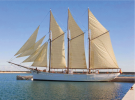- Time of past OR future Camino
- 2016, 2022, 2023, 2024, planned 2025
Today an article about going on a boat from Jaffe. Articles says they can take up to 1,000 volunteer crew members. It will replicate the journey of St James to Spain and the final leg will be on foot to Compestella.
Este año el Camino a Santiago se hace por mar - http://www.lavozdegalicia.es/noticia/yes/2022/06/11/ano-camino-santiago-mar/0003_202206SY11P8991.htm
Este año el Camino a Santiago se hace por mar - http://www.lavozdegalicia.es/noticia/yes/2022/06/11/ano-camino-santiago-mar/0003_202206SY11P8991.htm













